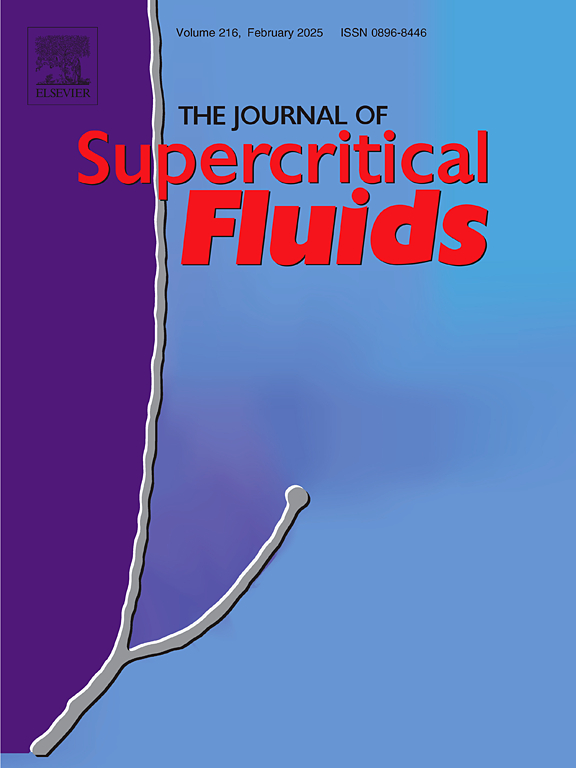A wall-temperature-independent heat transfer model and dominant dimensionless numbers for supercritical CO2 in vertical upward flow
IF 4.4
3区 工程技术
Q2 CHEMISTRY, PHYSICAL
引用次数: 0
Abstract
The heat transfer coefficient is a critical parameter for the design and optimization of supercritical carbon dioxide (sCO₂) heat exchange systems. Based on 20723 data points collected from 22 published studies, existing heat transfer correlations are evaluated, and a new model with improved stability and predictive accuracy is developed. Current correlations for upward vertical sCO₂ flow typically include wall-temperature-dependent parameters, which often lead to issues such as non-uniqueness or the absence of solutions during wall temperature prediction, along with limited accuracy. To address these issues, this study integrates the Buckingham Pi theorem and constructs a wall-temperature-independent heat transfer model using a dimensionless neural network. This approach avoids the problems of multiple or no solutions and achieves high predictive performance, with mean absolute relative errors of 2.83 % for wall temperature and 5.81 % for Nusselt number predictions. Furthermore, the active subspace method is employed to identify four dominant dimensionless groups governing the heat transfer process. These groups can be decomposed into products of commonly known dimensionless numbers. During this process, a new dimensionless number—the buoyancy generation (BG) number—is proposed and defined. This study leverages data-driven dimensional analysis to explore key influencing parameters and dominant dimensionless numbers for supercritical heat transfer, offering new insights into the underlying physical mechanisms.
超临界CO2垂直向上流动中不依赖壁面温度的传热模型和优势无因次数
换热系数是超临界二氧化碳(sCO 2)换热系统设计与优化的关键参数。基于22篇已发表的研究中收集的20723个数据点,对现有的传热相关性进行了评估,并建立了一个具有更高稳定性和预测精度的新模型。当前向上垂直sCO₂流动的相关性通常包括壁面温度相关参数,这通常会导致壁面温度预测过程中的非唯一性或缺乏解决方案等问题,同时精度有限。为了解决这些问题,本研究结合白金汉派定理,利用无量纲神经网络构建了与壁面温度无关的传热模型。该方法避免了多解或无解的问题,实现了较高的预测性能,对壁温的平均绝对相对误差为2.83 %,对努塞尔数的平均绝对相对误差为5.81 %。在此基础上,利用主动子空间方法确定了控制传热过程的4个主要无量纲群。这些群可以分解成众所周知的无量纲数的乘积。在此过程中,提出并定义了一个新的无量纲数——浮力生成数(BG)。本研究利用数据驱动的量纲分析来探索超临界传热的关键影响参数和主要无量纲数,为潜在的物理机制提供新的见解。
本文章由计算机程序翻译,如有差异,请以英文原文为准。
求助全文
约1分钟内获得全文
求助全文
来源期刊

Journal of Supercritical Fluids
工程技术-工程:化工
CiteScore
7.60
自引率
10.30%
发文量
236
审稿时长
56 days
期刊介绍:
The Journal of Supercritical Fluids is an international journal devoted to the fundamental and applied aspects of supercritical fluids and processes. Its aim is to provide a focused platform for academic and industrial researchers to report their findings and to have ready access to the advances in this rapidly growing field. Its coverage is multidisciplinary and includes both basic and applied topics.
Thermodynamics and phase equilibria, reaction kinetics and rate processes, thermal and transport properties, and all topics related to processing such as separations (extraction, fractionation, purification, chromatography) nucleation and impregnation are within the scope. Accounts of specific engineering applications such as those encountered in food, fuel, natural products, minerals, pharmaceuticals and polymer industries are included. Topics related to high pressure equipment design, analytical techniques, sensors, and process control methodologies are also within the scope of the journal.
 求助内容:
求助内容: 应助结果提醒方式:
应助结果提醒方式:


